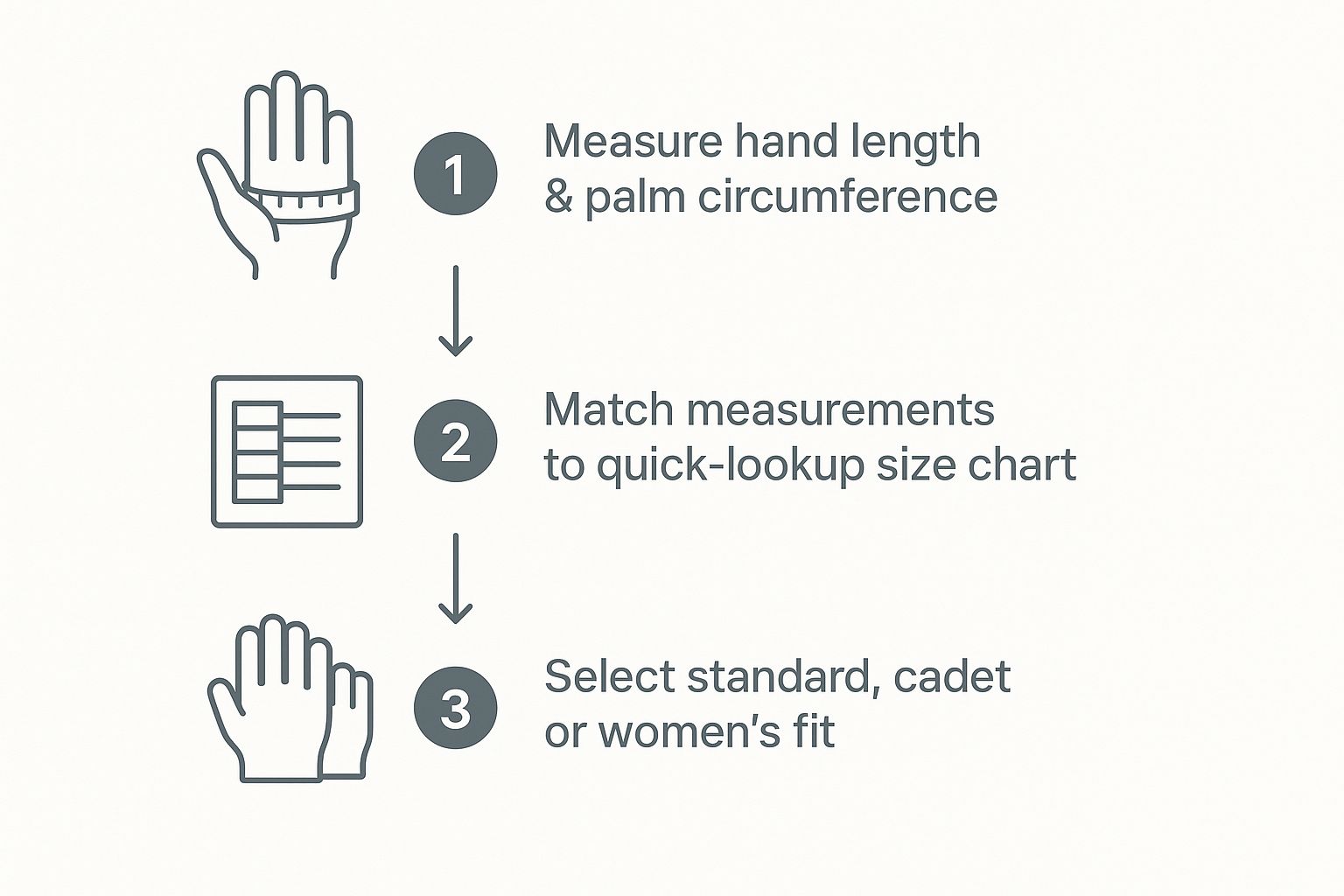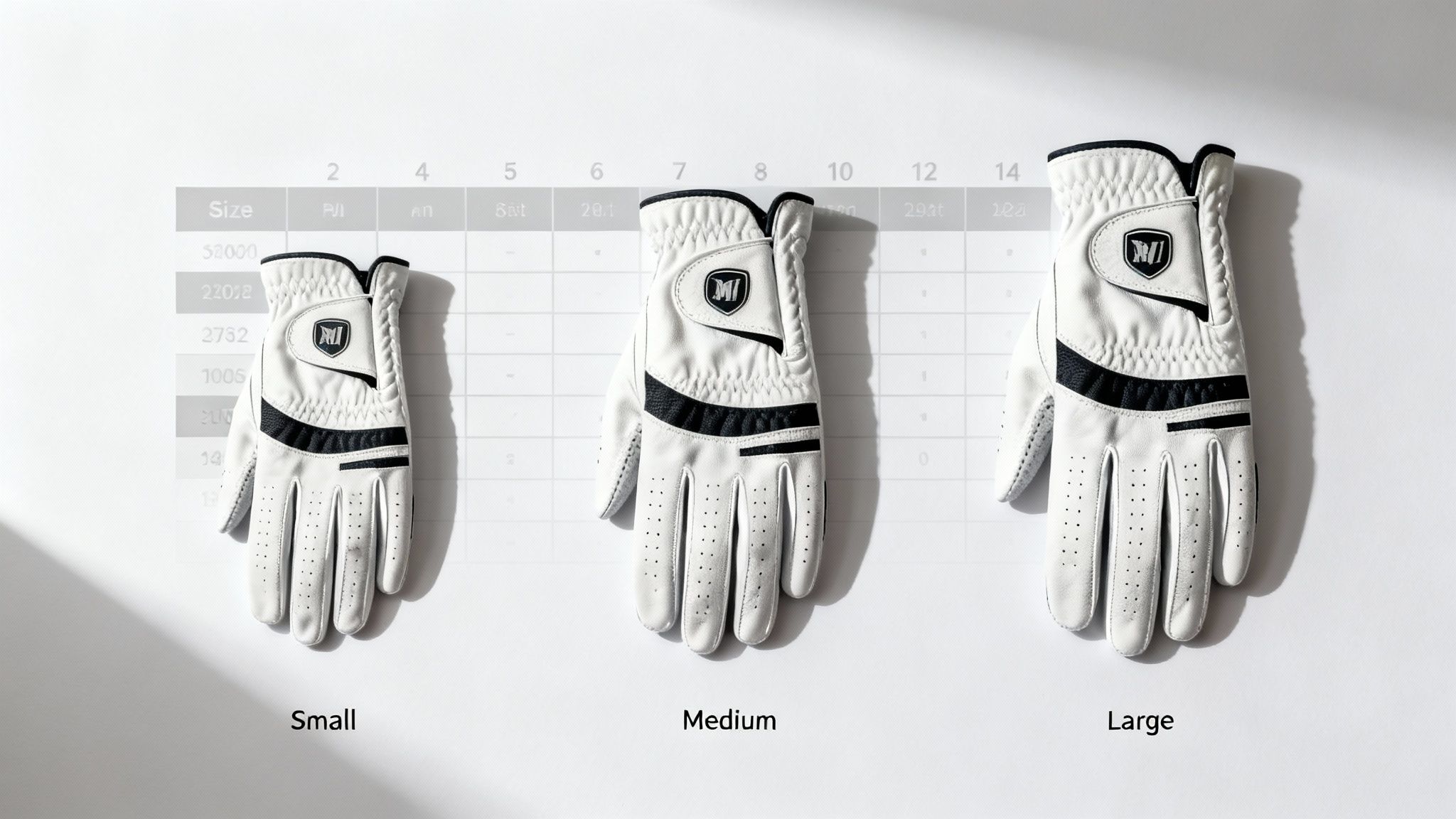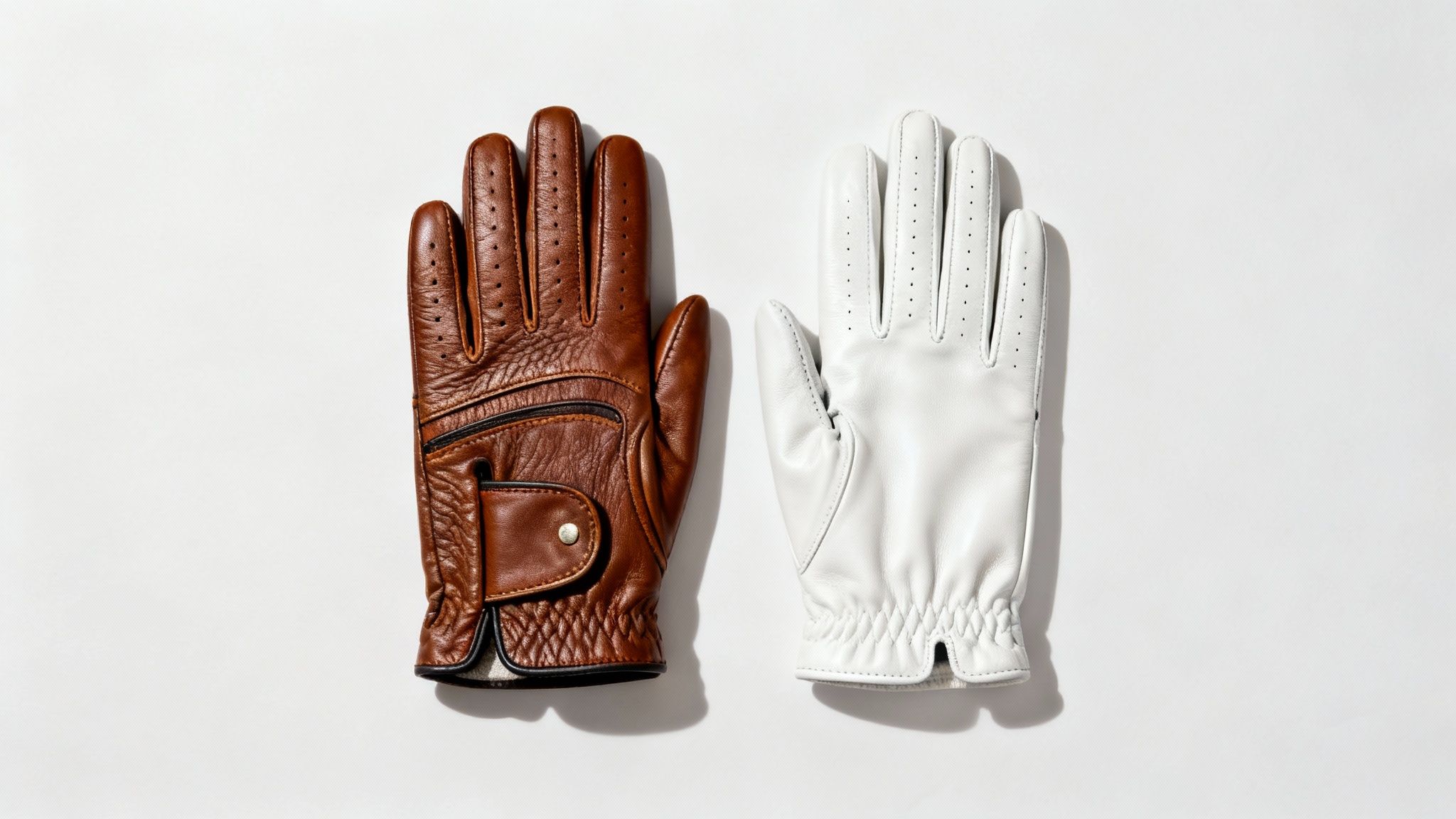Let's get one thing straight: a sloppy golf glove isn't just a minor irritation, it's a bonafide game-wrecker. Even the slightest bit of extra material can make the club slip or twist at the worst possible moment, killing your feel and sending your shot way off target. This guide is here to put an end to that sizing guesswork for good.
So, Why Does Glove Size Really Matter?
Think of your glove as a second skin. When it fits perfectly, it gives you a direct, unfiltered connection to the club, improving your grip and giving you the confidence to swing freely. A glove that's too loose or too tight messes with that feedback loop.
This isn't just a simple chart; we're diving deep. We'll cover how to measure your hand like a pro, what to do with those numbers, and even unravel the mystery of Standard vs. Cadet sizing. For more tips on getting the most out of your gear, swing by the 2nd Shot MVP blog after you're done here.
This whole process really boils down to three simple steps, as you can see below.

It’s a straightforward path: get your measurement, find your size on the chart, and pick the right style. Let's get to it.
How to Measure Your Hand Like a Pro
Let's be honest, grabbing a random glove off the rack and hoping it fits is a recipe for a bad round. Nailing your size comes down to two simple measurements—the same ones brands use to design their entire fit system. Getting this right is the most important thing you can do to make sure that glove you order online feels like a second skin right out of the box.
And you’re not alone in wanting that perfect fit. The global demand for golf gloves is expected to blow past $451 million by 2030. That’s a whole lot of golfers who understand how vital this piece of gear is. This boom is driven by new players and incredible new materials, making a custom-like fit more accessible than ever. You can dig into the numbers on the booming golf equipment market on Grandviewresearch.com.
So, let's get you measured up.
Step 1: Measure Hand Length
First things first, lay your dominant hand flat on a table, palm up. Take a flexible measuring tape and run it from the first crease at the bottom of your wrist straight up to the tip of your middle finger.

That number is your hand length. It's a good idea to write it down in both inches and centimeters, just to be safe.
Step 2: Measure Hand Circumference
Alright, for the second measurement, keep your hand flat. You're going to wrap the tape around your knuckles, right at the widest part of your hand just below the fingers.
The key here is to exclude your thumb. Just wrap the tape around those four knuckles. This gives you your hand circumference.
Once you have these two numbers, you're armed and ready. You can now walk up to any golf glove size chart and find your perfect match with total confidence.
Your Go-To Men's Golf Glove Size Chart
Alright, you've got your measurements—now for the fun part. Let's translate those numbers into the perfect glove. Think of this as the Rosetta Stone for golf glove sizing. We're not just grabbing a "Large" off the shelf; we're dialing in a fit that feels like a natural extension of your hand.
A glove that fits like a second skin is non-negotiable for real club control. So, take the length and circumference numbers you just jotted down and find your match below. This is your baseline for pretty much every major brand out there.

Now, here's a quick look-up table to make things even easier. Just find your hand measurement in inches or centimeters to see your recommended size for both Standard and Cadet gloves.
Men's and Cadet Golf Glove Size Conversion
| Hand Measurement (Inches) | Hand Measurement (CM) | Standard Men's Size | Cadet Size |
|---|---|---|---|
| 7.25" - 7.5" | 18.4 - 19.1 cm | Small | Cadet Small |
| 7.5" - 7.75" | 19.1 - 19.7 cm | Medium | Cadet Medium |
| 7.75" - 8" | 19.7 - 20.3 cm | Medium-Large | Cadet Medium-Large |
| 8" - 8.25" | 20.3 - 21 cm | Large | Cadet Large |
| 8.25" - 8.5" | 21 - 21.6 cm | X-Large | Cadet X-Large |
| 8.5" - 8.75" | 21.6 - 22.2 cm | XX-Large | Cadet XX-Large |
Remember, this chart is an excellent starting point. Every brand has its own little quirks, but this will get you squarely in the right ballpark every time.
But what happens when a standard glove just isn't cutting it? If you're constantly fighting with extra leather at the fingertips or a palm that feels way too loose, you might be the perfect candidate for a different cut.
Decoding the Mystery of Cadet Sizing
Ever seen "Cadet" printed on a glove package and scratched your head? You're not alone. It's the secret weapon for a surprisingly large number of golfers. In fact, some estimates suggest that over 20% of players would get a better fit from a Cadet size but have no idea it’s an option!
So, what's the deal with Cadet? It's simple, really.
- Wider Palm: Cadet gloves are designed for guys with slightly broader palms and backs of their hands.
- Shorter Fingers: They come with shorter finger stalls compared to the standard model of the same size.
Here's the classic example: If a standard Medium glove fits your palm perfectly but you've got that annoying, floppy space at the end of your fingers, try a Medium Cadet. That one small change can make a world of difference, giving you the snug, dialed-in fit you've been missing.
Think of it like this: a standard glove is your regular-fit t-shirt. A Cadet glove is the athletic-fit version—same quality, just cut for a different build. Always check your measurements against both columns in the chart to see which profile is the true winner for your hand.
A Complete Guide to Women's Golf Glove Sizing
Let's be honest, finding a women's golf glove that fits perfectly can feel like searching for a needle in a haystack. But it doesn't have to be that way. A common mistake is thinking women's gloves are just shrunken-down versions of men's. They're not.
The best glove makers craft women's gloves with a completely different blueprint. They're designed for proportionally longer fingers and narrower palms, which are typical anatomical differences. This specific design gets rid of that annoying bunching in the palm and the floppy, empty space at the fingertips, giving you a seamless connection to the club.
And it's about time, too! Women's golf is booming, with a projected market growth of 5.63% CAGR. We're seeing huge interest from all over the globe, especially in places like South Korea. If you're curious about the numbers, you can get the full scoop on the expanding global golf market on Mordor Intelligence. This worldwide surge is finally pushing brands to step up and create better, more precise sizing for everyone.
Women's Golf Glove Size Conversion Chart
Alright, you've got your measurements. Now it's time for the moment of truth. Use the chart below to find your perfect match. Just find your number and see what size it lines up with.
| Hand Measurement (Inches) | Hand Measurement (CM) | Women's Glove Size |
|---|---|---|
| 6.5" - 6.75" | 16.5 - 17.1 cm | Small |
| 6.75" - 7" | 17.1 - 17.8 cm | Medium |
| 7" - 7.25" | 17.8 - 18.4 cm | Medium-Large |
| 7.25" - 7.5" | 18.4 - 19.1 cm | Large |
Think of a great golf glove as a second skin. When you clench your fist, the material across your palm should be taut, with no wrinkles or bagginess. The velcro tab should close about three-quarters of the way across, leaving you a little wiggle room for adjustments as the leather naturally stretches over time. This is the secret to getting maximum control and feel on every single shot.
Choosing the Right Glove Material
So, you've got your measurements dialed in. Awesome. But don't race to the checkout just yet, because the material of your glove is just as important as the size. This is where the real nuance comes in, and your choice will totally change the glove's feel, performance, and how long it lasts.
Ultimately, it all boils down to the classic golf showdown: feel versus durability.
The undisputed king of feel is Cabretta leather. This stuff is the good stuff, made from the hide of hairsheep, and it’s legendary for its buttery-soft texture and insane feedback. Think of it as a second skin that gives you a pure, unfiltered connection to the club. The trade-off for all that luxury? Cabretta is a bit of a diva; it's less resistant to moisture and will wear out faster than its synthetic cousins.

Synthetics and Hybrids
On the other side of the aisle, you've got synthetic gloves. These are the workhorses. Built to last, they laugh in the face of humidity and give you a consistent fit from the first swing to the last. They won't stretch out like leather, making them a super reliable choice.
And for those who want the best of both worlds? Say hello to hybrid gloves. These clever designs blend materials, often using leather in the palm and fingers for that critical feel, while incorporating synthetic fabrics across the knuckles and back for better flexibility and breathability. It's a great compromise.
Here's the one thing you absolutely need to remember: leather stretches, synthetics don't. If you're stuck between two sizes on a chart, go with the smaller size for a leather glove. After a few rounds, it’ll mold to your hand like it was custom-made.
A premium glove deserves an equally sharp outfit. To complete your look on the course, take a peek at the top-tier styles in our collection of men's MVP golf polos.
The Pro's Checklist for a Perfect Fit
Alright, so you've measured your hand and consulted the size chart. You've got a number. But let's be honest, the true test happens the moment you slide that glove on. Any seasoned golfer will tell you that finding the right fit is less about the numbers and more about the feel.
This isn't just a comfort thing; it's a performance thing. A glove that feels like an extension of your hand gives you a direct line of communication with the club. It's the final quality check before you step up to the first tee.
The Second Skin Test
When you first try on a new glove, it should feel snug—maybe even a little too tight. That's actually a good sign. Quality leather has a bit of give and will stretch to form a perfect mold of your hand after a round or two.
Here are the key checkpoints to nail that second-skin fit:
- Fingertip Space: Look at the tips of your fingers. You should see no more than a quarter-inch of extra material. Any more than that, and you'll get annoying friction and lose that critical feel for the club.
- The Velcro Tab: Fasten the closure tab. It should only cover about 75% of the velcro patch. This gives you some room to cinch it down as the leather naturally relaxes with use.
- The Palm Check: Make a tight fist. The material across your palm and knuckles should pull taut, without any bunching or wrinkles. If it bunches up, the glove is too big.
A great fit means you can practically forget you’re wearing a glove. If you're constantly adjusting it, it's not the right one.
This level of detail is what separates good golf from great golf, and it applies to all your gear. Speaking of which, keeping your favorite cap in prime condition is just as crucial. For some pro tips on that, take a look at our guide on how to clean golf hats.
Answering Your Nagging Golf Glove Sizing Questions
Even with a perfect measurement and a trusty chart, you're bound to have questions. It happens to everyone. Think of this as your personal FAQ caddie, here to sort out the common puzzles we hear about all the time. Let's get these last few details ironed out so you can pick your glove with total confidence.
Getting these little things right—like what to do when you're stuck between sizes or when to finally toss that old, crusty glove—can genuinely impact your game.
What if I’m Stuck Between Two Sizes?
Ah, the classic sizing showdown. The answer is simple: always size down. A brand-new leather glove is meant to be snug, almost like a second skin. It's built to stretch and form perfectly to your hand after a few rounds of play.
If you go with the larger size, you’re asking for trouble. The extra material will bunch up in your palm and slip during your swing. Not only is that uncomfortable, but it's a surefire way to get blisters and lose that crucial connection to the club.
Does Sizing Vary Between Golf Glove Brands?
You bet it does. Just like your favorite pair of jeans, a "Medium" from one brand can feel totally different from another. This is exactly why measuring your own hand is the most important step. That measurement is your baseline, your single source of truth.
Always use your hand length and circumference measurements, and check them against the specific golf glove size chart for whatever brand you're about to buy. It’s a simple step that takes all the guesswork out of the equation.
How Often Should I Replace My Golf Glove?
A solid rule of thumb is to replace your glove every 10 to 15 rounds. A more immediate sign is when you see major wear and tear on the palm, or if the leather gets stiff and loses that tacky feeling. Once it's crusty, its job is done.
Pro tip: Keep your glove in a sealed plastic bag between rounds. It’ll help it last a lot longer.
Why Do Golfers Only Wear a Glove on One Hand?
It all comes down to grip and feel. Golfers wear a glove on their "lead" hand (the left hand for a righty), which is the hand that applies most of the grip pressure on the club. The glove prevents blisters and stops the club from twisting during the swing.
The other hand, the "trail" hand, is left bare. This gives you a much better feel for the club, which is incredibly important for those delicate touch shots around the green. It’s the best of both worlds—power and finesse.
Now that your hand is perfectly fitted, top off your on-course style with some premium headwear from 2ndShotMVP. Find your next go-to hat or beanie by checking out the collection at https://2ndshotmvp.com.
Article created using Outrank



